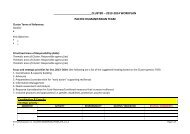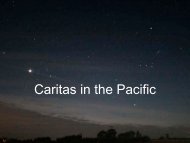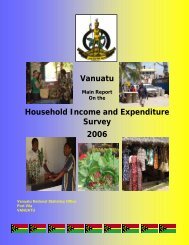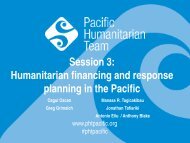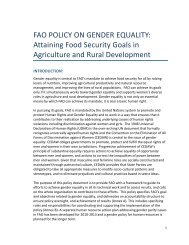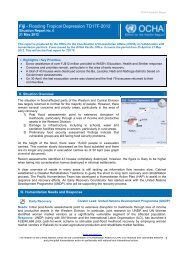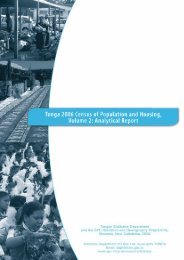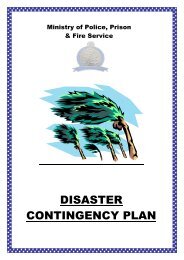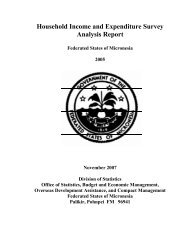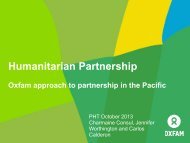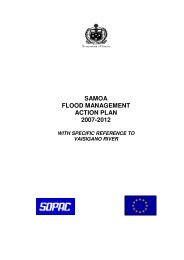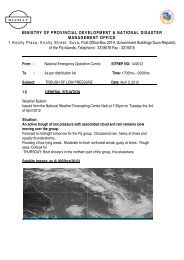Solomon Islands - Asia & the Pacific
Solomon Islands - Asia & the Pacific
Solomon Islands - Asia & the Pacific
Create successful ePaper yourself
Turn your PDF publications into a flip-book with our unique Google optimized e-Paper software.
<strong>Solomon</strong> <strong>Islands</strong>: Analysis of Poverty from 2005/2006 HIESNational Poverty Lines and Estimates of <strong>the</strong> Incidence in of Poverty in <strong>Solomon</strong> <strong>Islands</strong>1. Purpose of Paper1. The purpose of this paper is to provide estimates of National Poverty Lines and <strong>the</strong> incidence of poverty for<strong>Solomon</strong> <strong>Islands</strong> based on an analysis of <strong>the</strong> household data from <strong>the</strong> national 2005/06 Household Income andExpenditure Survey (HIES).2. The HIES contains a wealth of information. This paper analyses <strong>the</strong> expenditure data to estimate <strong>the</strong> incidence ofpoverty through <strong>the</strong> Head Count Index (HCI) 2 by comparing food and basic needs poverty lines with recordedlevels of expenditure. It also estimates indicators of <strong>the</strong> depth (Poverty Gap Index, PGI) and severity (SquaredPoverty Gap Index, SPGI) of poverty in <strong>Solomon</strong> <strong>Islands</strong> and levels of income/consumption inequality through <strong>the</strong>Gini Coefficient.3. It fur<strong>the</strong>r provides an analysis of <strong>the</strong> broad characteristics of low-expenditure households in terms of <strong>the</strong>ir socioeconomicstatus, demographics and level of household access to basic services. Toge<strong>the</strong>r with <strong>the</strong> povertyindicators <strong>the</strong>se provide a good indication of which households are <strong>the</strong> most disadvantaged in <strong>Solomon</strong> <strong>Islands</strong>,what common characteristics <strong>the</strong>y might share and why <strong>the</strong>y might be in this situation of disadvantage andhardship. Such information will be useful for government to define targeted policies and interventions to assist inalleviating <strong>the</strong>ir poverty and hardship.4. Specifically <strong>the</strong> paper will:- Discuss <strong>the</strong> definition and context of poverty in <strong>the</strong> <strong>Pacific</strong> and <strong>Solomon</strong> <strong>Islands</strong> in particular, Section 2;- Outline <strong>the</strong> poverty analysis methodology used and provide an overview of some of <strong>the</strong> key householdand socio-economic indicators from <strong>the</strong> HIES, Section 3;- Estimate food and basic needs poverty lines for Honiara, provincial-urban and rural households 3 ; Sections4 & 5;- Provide indications of <strong>the</strong> incidence, depth and severity of poverty, and estimates of <strong>the</strong> extent ofinequality in expenditure (or income) between regions and households in Honiara, provincial-urban andrural areas, Section 6;- Outline <strong>the</strong> characteristics of poor households, defined as those in <strong>the</strong> lowest three deciles of per capitaadult equivalent expenditure, Section 7; and- Provide a summary of key policy issues arising from <strong>the</strong> analysis, section 8.5. This report presents <strong>the</strong> first attempt to establish national poverty lines for <strong>Solomon</strong> <strong>Islands</strong>. It is <strong>the</strong>refore abenchmark analysis that provides a basis for both identifying policies and monitoring <strong>the</strong> impact of targeted propoorpolicies and strategies in <strong>the</strong> medium term development framework. <strong>Solomon</strong> <strong>Islands</strong> is a signatory to <strong>the</strong>Millennium Declaration and has endorsed <strong>the</strong> Millennium Development Goals (MDGs) as key development targetsfor achievement by 2015 and support for which is an overarching goal of all <strong>the</strong> agencies that have contributedto this analysis. The better understanding of hardship and poverty in <strong>Solomon</strong> <strong>Islands</strong> afforded by this analysis will<strong>the</strong>refore help to integrate <strong>the</strong> core poverty reduction focus of <strong>the</strong> MDGs in to national strategies. The informationand data contained in <strong>the</strong> HIES and in <strong>the</strong> analysis will contribute to an improved ability to monitor progresstowards <strong>the</strong> goals.2 The Head Count Ratio is not <strong>the</strong> same as <strong>the</strong> Poverty Indicator in Millennium Development Goal 1. The MDG 1 indicator, based on US$1 per day, is not yet available for <strong>Solomon</strong><strong>Islands</strong>, or any o<strong>the</strong>r <strong>Pacific</strong> island Countries, as estimates of <strong>the</strong> Purchasing Power Parity exchange rates required to calculate <strong>the</strong> MDG indicator have not yet been finalised by SPCand <strong>the</strong> Australian Bureau of Statistics (ABS). The MDG 1 indicator, when available, will enable direct comparisons of ‘absolute” poverty levels to be made between countries. Nationalpoverty lines, which are used in this analysis, enable assessments of relative poverty within countries.3 The survey defined households as units “where normal family or household living arrangements are exercised”; and <strong>the</strong>refore excludes institutional housing such as schools,hospitals etc.Estimation of National Poverty Lines and Poverty Incidence



